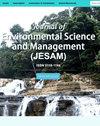西南林分凋落物溶解有机碳和阳离子的淋溶及缓冲能力
IF 0.3
4区 环境科学与生态学
Q4 ENVIRONMENTAL SCIENCES
引用次数: 1
摘要
森林土壤具有缓冲酸化和中和酸性大气污染物的作用,但对于酸性雨水,它在到达土壤之前先与森林生态系统中的森林凋落物接触。然而,对不同酸负荷率处理的森林凋落物渗滤液化学性质的研究却很少。在pH分别为2.7、3.5和4.5的模拟酸雨条件下,对三峡库区缙云山针叶阔叶混交林(MCB)和常绿阔叶林(EB)凋落物进行淋滤试验。在不同酸负荷率下,MCB和EB均可输出溶解有机碳(DOC)和阳离子。大量的DOC、Ca2+和Mg2+淋滤液对森林凋落物的雨水脱酸有促进作用。不同凋落物组成下,EB的酸缓冲能力强于MCB。随着SAR pH值的降低,阳离子的淋出量增加,EB比MCB更易分解,但其释放的Al3+高于MCB,但其淋滤液Ca/Al比值未达到临界值1.0。因此,在研究区,EB林可能是造林和再造林的较好选择,森林凋落物较好,具有良好的缓冲能力,可以防止土壤酸化,是其下土壤更大的养分池。本文章由计算机程序翻译,如有差异,请以英文原文为准。
Leaching of Dissolved Organic Carbon and Cations and the Buffering Capacity of Litters from Forest Stands in Southwestern China
Forest soil can buffer acidification and neutralize acidic airborne pollutants, but for acid rainwater, it makes contact with forest litter in the forest ecosystem first before reaching the soil. However, leachate chemistry of forest litter treated with different acid load rates is rarely studied. A leaching experiment was performed on forest litter from mixed conifer-broadleaf (MCB) and evergreen broadleaf (EB) forests in Jinyun Mountain, Three Gorges area, Southwestern China with simulated acid rain (SAR) of pH=2.7, 3.5 and 4.5. Dissolved organic carbon (DOC) and cations were exported from MCB and EB when treated with various acid load rates. The rainwater deacidification of forest litter was enhanced by considerable leachate concentrations of DOC, Ca2+and Mg2+. The acid buffering capacity of EB was stronger than MCB with different composition of forest litter. Leaching of cations increased with decreasing pH of SAR. Although more easily decomposed, EB released greater Al3+ than MCB, leachate Ca/Al ratios of EB did not reach the critical value of 1.0. Thus, in the study area, EB forest may be a better choice for afforestation and reforestation with better forest litter, showing good buffering capacity, keeping soil from acidification and being a greater nutrient pool for soil under it.
求助全文
通过发布文献求助,成功后即可免费获取论文全文。
去求助
来源期刊

Journal of Environmental Science and Management
ENVIRONMENTAL SCIENCES-
CiteScore
0.90
自引率
0.00%
发文量
10
审稿时长
2 months
期刊介绍:
The Journal of Environmental Science and Management (JESAM) is an international scientific journal produced semi-annually by the University of the Philippines Los Baños (UPLB).
JESAM gives particular premium to manuscript submissions that employ integrated methods resulting to analyses that provide new insights in environmental science, particularly in the areas of:
environmental planning and management;
protected areas development, planning, and management;
community-based resources management;
environmental chemistry and toxicology;
environmental restoration;
social theory and environment; and
environmental security and management.
 求助内容:
求助内容: 应助结果提醒方式:
应助结果提醒方式:


